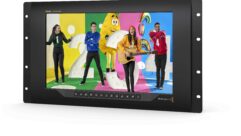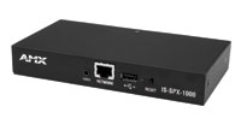
Installation Profile: Resolution Revolution
Oct 1, 2007 12:00 PM,
BY Jay Ankeney
Digital cineplex draws viewers with top-notch 4K projection.

With HD DVD and Blu-ray Discs providing quality that rivals a night out at the movies, Muvico Entertainment has upped the ante with its new Chicago cineplex, the
Rosemount 18. Sony 4K projectors (including the SRX-R220 4K SXRD shown below) provide theatergoers with the ultimate in superior projection on Hurley Superglow and Silver Screen screens.
Hollywood is coming to Chicago in a big way. Sure, the City of Broad Shoulders has had movie palaces since the days of the silent flickers. But until now, nobody has seen a movie theater complex like the Rosemount 18 that Muvico Entertainment has put up near the Chicago O’Hare International Airport.
Not only will this new cineplex have 18 state-of-the-art digital cinema auditoriums, with two of them even capable of 3D presentations, but all of the projectors will be Sony’s new 4K design, blasting out 4096×2160 pixels using SXRD imaging technology. SXRD stands for Silicon X-tal Reflective Display, where “X-tal” is an abbreviation for crystal. That means the theaters will have not just twice, but four times the resolution of the vast majority of today’s 2K (2048×1080) digital-cinema theaters.
According to the trade publication DCinema Today, there are more than 4,885 D-Cinema-grade screens installed worldwide, 3,595 of which are in the United States alone. These all present a resolution of at least 2K for feature film presentations, although increasingly even 35mm theaters use HD-resolution (1920×1080) projectors for their pre-shows.
But few of them can match the splendor of the Rosemount 18, because Muvico theaters set a destination venue standard in themed theaters with amenities such as eating and drinking services in separate over-21 VIP reserved-seating areas, child-care facilities, guarded parking, and Internet ticketing. The food is even supplied by Chicago’s popular Bogart’s Bar & Grill, with a menu ranging from steak to sushi. As its publicity proudly boasts, “Muvico believes in offering the guest an integrated entertainment experience … where the ‘movie is part of the overall entertainment experience.’”

A centralized command center equipped with Sony LSM-100 monitoring software and SMSC-equipped workstations enables Muvico’s technical staff to conveniently operate and monitor the status of the complex’s 18 screens.
It seems to be working for the theater chain, and it’s a good bet that as the first all-4K theater in the United States since its Sept. 14 grand opening, the new Rosemount 18 will be giving the others a run for their money.
“Muvico acted as the overall systems integrator overseeing the project,” says Darryl Leversuch, director of technical services at Muvico Entertainment, “although we did contract out the sound system, theater screen, and seating installation. The projection booths were intentionally designed with the same parameters that would be used for 35mm purposes, but of course, Sony installed the 4K projectors and their LMT-100 4K Media Block servers that feed them with JPEG2000 files.”
PROJECTING QUALITY
There is a legend about the Sony 4K projectors that started to circulate several years ago during their early testing stage. With no video cameras available that could capture a 4K image, the Sony engineers transferred footage from sources such as the 65mm negatives of 70mm theatrical prints. As the legend goes, only when a scene from The Sound of Music was projected in 4K was it noticed that while Julie Andrews was singing to the kids on that Alpine mountaintop, she had a hair sticking straight up from the top of her head. The resolution lost by printing the negative to celluloid release stock had blurred it; the 4K transfer struck directly from the camera negative revealed the wayward hair for the first time.
Today, thanks to the Digital Cinema Initiative (DCI), formed by a consortium of seven Hollywood studios to set specifications for digital-cinema exhibitions, both 2K and 4K presentations have been accepted by the major studios. The Landmark theater chain has 12 Sony 4K projectors installed individually in theaters across the United States. Now that Muvico has committed to 4K presentations throughout its Rosemount 18 installation, interest in 4K presentation is starting to take center stage. Almost every new feature film release is mastered in 4K because it is easy to extract 2K presentations from a 4K file, and 4K has the additional advantage of providing a superior archiving medium. Warner Bros. has already committed to making all of its future releases available in 4K.
In addition, there are now two video cameras, the Origin from Dalsa and the Red One from Red Digital Cinema, that can actually shoot in 4K. Steven Soderbergh is already shooting his next two movies, Guerilla and The Argentine, with the Red One camera in 4K. Many Hollywood insiders predict that with postproduction processes stepping up to the challenge of handling these super-large files, we can look forward to seeing motion pictures originated with 4K digital cinematography become a high-resolution rival to film as a standard for big-screen acquisition.
“We feel that 4K underlines the distinction of the viewing experience between a home theater and going out to the movies,” says Andrew Stucker, director of the digital-cinema division at Sony Electronics. “With the support of the DCI and the major studios, we believe that 4K presentations will someday become the standard for theatrical exhibitions. With HD DVD and Blu-ray Discs providing about 1.5K resolution on a home screen, we need to give people a reason to go out to see a movie.”
So the Rosemount 18 has four auditoriums with Sony SRX-S110 projectors throwing out 10,000 ANSI lumens, two with double-stacked SRX-S110s for 3D presentations, and the remaining 12 of the larger halls with SRX-R220s providing 18,000 ANSI lumens.
But, of course, going out for a night at the movies involves much more than just superior projection. Digital cinema also requires improved screens to take advantage of its resolution, so Muvico’s Leversuch contracted Lewis Theatrical Installations (LTI) to install them. Its owner, Royce Lewis, chose Hurley Superglow screens for the custom installation in the 16 2D theaters to disperse the images across the breadth of the seating rows, but he had to put Silver Screen screens in the 3D auditoriums to provide the more direct reflection required by the stereoscopic dual projectors. Ranging from 30ft. to 60ft. wide and 16ft. to 25ft. tall, all the screens were suspended on springs to keep them tight.
In a modern theater, each screen has to be ready to handle a variety of image proportions ranging from the standard, nearly square Academy aspect ratio of 1.37:1, all the way out to CinemaScope’s widescreen 2.39:1. To move the masking on the top, bottom, and sides of the screen, Lewis ran a motorized cable around the parameter of each screen twice. By pulling the cable, the masks change the part of the screen visible to the audience.
Before hanging the screens, however, Lewis’ crew mounted the center, left, and right loudspeakers that sit directly behind them. These loudspeakers later had to be “aimed” or put in final position by the sound system installer. Chicago Motion Picture Sales Service (CMPSS) installed the loudspeakers after the company owner, George Smiley, heard about the installation and called Leversuch last March. All the loudspeakers were made by JBL, and Smiley used an active crossover circuit between the low and midrange frequencies and a passive crossover between the midrange and high frequencies. Then CMPSS used an 85dB pink noise generator to make sure that the throat of each loudspeaker was properly directed. The installer monitored the loudspeakers’ output with four microphones positioned in the audience to make sure the sound reproduction was flat across all octaves.
These days, all movies are mixed for Dolby 5.1 Digital Surround Sound, with many theaters adding two extra center rear loudspeakers in the Dolby Digital EX format. That gives each theater the capability of 8-channel sound when it is needed — left front, center front, and right front, along with left rear, left center rear, right center rear, and right rear. Smiley installed a Dolby CP-650EX sound processor and QSC DCA-1644 and DCA-2422 amplifiers averaging 10,000W in each theater. After setting the system for 85dB mean output and equalizing the overall sound in each auditorium, CMPSS installed audio racks and connections in all the projection booths.
To verify the fidelity of the loudspeakers’ output, Smiley used an R2 realtime analyzer made by THX, the LucasFilm sound division, although Muvico decided not to get official THX certification because it was not using official THX timed crossovers, among other reasons.
In keeping with its philosophy of providing a superior moviegoing experience, Muvico asked San Diego-based Seating Concepts to provide extra-wide, 26in. custom seats. Six of the 18 auditoriums have special VIP seating in their adult sections, which allows one-third of the audience to sit on double-sized love seats. In five of those auditoriums, the VIP area is in the upper-level gallery seating, with the final theater being completely devoted to adult VIP patrons. In keeping with Muvico’s “themed” concept, Muvico executives worked with Seating Concepts’ cinema sales manager, John Fennell, to design a special look for the Rosemount 18’s furniture.

Muvico chose double-sized love seats with a vintage look from Seating Concepts for its special adult VIP seating areas.
“Muvico wanted something that looks very vintage,” Fennell says, “so we started looking through old movie theater catalogs. The son of our founder, Mr. José Letayf, picked out a look reminiscent of a high-backed wing chair, and that is what the Muvico executives decided to select. It makes sitting in the VIP areas a unique experience.”
According to Muvico’s Leversuch, the company had two reasons to launch into the Rosemount 18 installation. “First, it’s not a bad thing to be associated with a brand like Sony and their 4K projector,” he says. “We feel this will be an extra draw for the audience, and the 4K resolution makes this a forward-looking capital investment on our part. In addition, we are looking to use this venue for alternative-content programming now that we have a delivery system that people can really get excited about.
“We figure the total equipment package for a 35mm installation costs about $35,000, just for the projector and film platter. A digital installation with a Sony 4K projector and server costs around $85,000 per screen. But we feel we are on the cusp of this becoming the quality of presentation that the audience is going to expect.”
Perhaps even more importantly, the lure of alternative programming promises to provide new opportunities for the theater’s owners. Four years ago, as an experiment, Muvico presented a live Tampa Bay Buccaneers game with 2K projection in its Ybor Theater in Ybor, Fla., (near Tampa) in a 200-seat auditorium. Once the word got out, the theater chain was able to fill two whole theaters for the following week’s Bucs game. A tangle of red tape ended that attempt to bring live sports to the home-team audience, but now Muvico is looking forward to presenting additional sporting events, including live NASCAR races, on its big digital screens. It is also aware that with Sony’s ties to the music industry, concert performances on the big screen could be another big draw.
“The image of 4K digital cinema is fantastic,” Leversuch says. “And we feel this is going to help enhance the image of the whole Muvico theater chain as the nation’s premier destination moviegoing experience.”
For More Information
Dalsa
www.dalsa.com
Dolby Laboratories
www.dolby.com
Hurley
www.hurleyscreen.com
Red Digital Cinema
www.red.com
Seating Concepts
www.seatingconcepts.com
THX
www.thx.com
Jay Ankeneyis an industry consultant and former TV network engineer living in the Los Angeles area.








